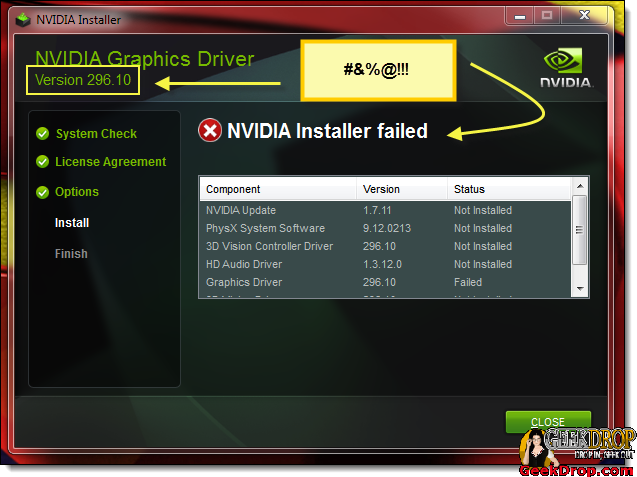
What Is Nvidia Graphics Driver
Jan 30, 2011 - Note: Before proceeding with the installation, verify the driver you downloaded supports your graphics card. Geforce Desktop PC graphics. Certain NVIDIA graphics cards (mainly graphics cards released in the last year and a half) and some NVIDIA motherboards with onboard NVIDIA graphics controller include a native HDMI audio codec to send audio from your PC through an HDMI cable to an HDMI equipped HDTV, projector or receiver.
This article is about the Nvidia brand name. For other uses, see.
GeForce graphics processor Manufacturer Introduced August 31, 1999; 19 years ago ( 1999-08-31) Type Consumer GeForce is a of (GPUs) designed. As of the GeForce 20 series, there have been fifteen iterations of the design. The first GeForce products were discrete GPUs designed for add-on graphics boards, intended for the high-margin PC gaming market, and later diversification of the product line covered all tiers of the PC graphics market, ranging from cost-sensitive GPUs integrated on motherboards, to mainstream add-in retail boards. Most recently, GeForce technology has been introduced into Nvidia's line of embedded application processors, designed for electronic handhelds and mobile handsets. With respect to discrete GPUs, found in add-in graphics-boards, Nvidia's GeForce and 's GPUs are the only remaining competitors in the high-end market.
Along with its nearest competitor, the AMD Radeon, the GeForce architecture is moving toward (GPGPU). GPGPU is expected to expand GPU functionality beyond the traditional rasterization of 3D graphics, to turn it into a high-performance computing device able to execute arbitrary programming code in the same way a CPU does, but with different strengths (highly parallel execution of straightforward calculations) and weaknesses (worse performance for complex decision-making code). Main article: Launched in April 2000, the first GeForce2 (NV15) was another high-performance graphics chip.
Nvidia moved to a twin texture processor per pipeline (4x2) design, doubling texture fillrate per clock compared to GeForce 256. Later, Nvidia released the GeForce2 MX (NV11), which offered performance similar to the GeForce 256 but at a fraction of the cost.
The MX was a compelling value in the low/mid-range market segments and was popular with OEM PC manufacturers and users alike. The GeForce 2 Ultra was the high-end model in this series. GeForce 3 series [ ]. Main article: Launched in February 2002, the then-high-end GeForce4 Ti (NV25) was mostly a refinement to the GeForce3. The biggest advancements included enhancements to anti-aliasing capabilities, an improved memory controller, a second vertex shader, and a manufacturing process size reduction to increase clock speeds.
Another member of the GeForce 4 family, the budget GeForce4 MX, was based on the GeForce2, with the addition of some features from the GeForce4 Ti. It targeted the value segment of the market and lacked pixel shaders. Most of these models used the 4× interface, but a few began the transition to AGP 8×.
GeForce FX series [ ]. U3 driver. Main article: Launched in 2003, the GeForce FX (NV30) was a huge change in architecture compared to its predecessors.
The GPU was designed not only to support the new Shader Model 2 specification but also to perform well on older titles. However, initial models like the GeForce FX 5800 Ultra suffered from weak shader performance and excessive heat which required infamously noisy two-slot cooling solutions. Products in this series carry the 5000 model number, as it is the fifth generation of the GeForce, though Nvidia marketed the cards as GeForce FX instead of GeForce 5 to show off 'the dawn of cinematic rendering'. GeForce 6 series [ ].
Main article: The seventh generation GeForce (G70/NV47) was launched in June 2005 and was the last Nvidia video card series that could support the bus. The design was a refined version of GeForce 6, with the major improvements being a widened pipeline and an increase in clock speed. The GeForce 7 also offers new transparency and transparency multisampling anti-aliasing modes (TSAA and TMAA). These new anti-aliasing modes were later enabled for the GeForce 6 series as well.
The GeForce 7950GT featured the highest performance GPU with an AGP interface in the Nvidia line. This era began the transition to the PCI-Express interface. A 128-bit, 8 ROP variant of the 7950 GT, called the, is used as the main GPU in the Sony. GeForce 8 series [ ]. Main article: Released on November 8, 2006, the eighth-generation GeForce (originally called G80) was the first ever GPU to fully support 10. Manufactured using a 90 nm process and built around the new, it implemented the.
Initially just the 8800GTX model was launched, while the GTS variant was released months into the product line's life, and it took nearly six months for mid-range and OEM/mainstream cards to be integrated into the 8 series. The die shrink down to and a revision to the G80 design, codenamed G92, were implemented into the 8 series with the 8800GS, 8800GT and 8800GTS-512, first released on October 29, 2007, almost one whole year after the initial G80 release. GeForce 9 series and 100 series [ ]. Main articles: and The first product was released on February 21, 2008. Not even four months older than the initial G92 release, all 9-series designs are simply revisions to existing late 8-series products.